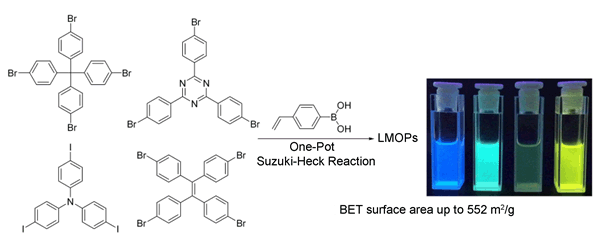| [1] (a) Dawson, R.; Cooper, A. I.; Adams, D. J. Prog. Polym. Sci. 2012, 37, 530;
(b) Wu, D.; Xu, F.; Sun, B.; Fu, R.; He, H.; Matyjaszewski, K. Chem. Rev. 2012, 112, 3959;
(c) Xu, Y. Jin, S.; Xu, H.; Nagai, A.; Jiang, D. Chem. Soc. Rev. 2013, 42, 8012.
[2] Yu, J. H.; Yan, W. F. Chemistry of Nanoporous Materials, Science Press, Beijing, 2013. (于吉红, 闫文付主编, 纳米孔材料化学, 科学出版社, 北京, 2013.)
[3] (a) Kaur, P.; Hupp, J. T.; Nguyen, S. T. ACS Catal. 2011, 1, 819;
(b) Zhang Y.; Riduan, S. N. Chem. Soc. Rev. 2012, 41, 2083;
(c) Liang, L.-Y.; Li, B.-Y.; Chen, B.; Zhou, B.; Chen, K.-P.; Tan, B.-E. Polym. Bull. 2008, 10, 6. (梁丽芸, 李步怡, 陈冰, 周壁, 陈可平, 谭必恩, 高分子通报, 2008, 10, 6);
(d) Han, S. S.; Furukawa, H.; Yaghi, O. M.; Goddard, W. A. J. Am. Chem. Soc. 2008, 130, 11580.
[4] (a) Côté, A. P.; Benin, A. I.; Ockwig, N. W.; Matzger, A. J.; O'Keeffe M.; Yaghi, O. M. Science 2005, 310, 1166;
(b) El-Kaderi, H. M.; Hunt, J. R.; Mendoza-Cortés, J. L.; Côté, A. P.; Taylor, R. E.; O'Keeffe M.; Yaghi, O. M. Science 2007, 316, 268.
[5] (a) Feng, X.; Ding X.; Jiang, D. Chem. Soc. Rev. 2012, 41, 6010;
(b) Ding S.-Y.; Wang, W. Chem. Soc. Rev. 2013, 42, 548.
[6] (a) Uribe-Romo, F. J.; Hunt, J. R.; Furukawa, H.; Klock, C.; O'Keeffe, M.; Yaghi, O. M. J. Am. Chem. Soc. 2009, 131, 4570;
(b) Jin, Y.; Zhu, Y.; Zhang, W. CrystEngComm 2013, 15, 1484.
[7] (a) Weber, J.; Antonietti, M.; Thomas, A. Macromolecules 2008, 41, 2880;
(b) Wang, Z.; Zhang, B.; Yu, H.; Sun, L.; Jiao, C.; Liu, W. Chem. Commun. 2010, 46, 7730.
[8] (a) McKeown, N. B.; Budd, P. M. Chem. Soc. Rev. 2006, 35, 675;
(b) McKeown, N. B.; Gahnem, B.; Msayib, K. J.; Budd, P. M.; Tattershall, C. E.; Mahmood, K.; Tan, S.; Book, D.; Langmi H. W.; Walton, A. Angew. Chem., Int. Ed. 2006, 45, 1804.
[9] (a) Kou, Y.; Xu, Y.; Guo, Z.; Jiang, D. Angew. Chem., Int. Ed. 2011, 50, 8753;
(b) Guo J.; Xu, Y. Jin, S.; Chen, L.; Kaji, T.; Honsho, Y.; Addicoat, M. A.; Kim, J.; Saeki, A.; Ihee, H.; Seki, S.; Irle, S.; Hiramoto1, M.; Gao, J.; Jiang, D. Nat. Commun. 2013, 4, 2736.
[10] Rabbani M. G.; El-Kaderi, H. M. Chem. Mater. 2011, 23, 1650.
[11] Macintyre, F. S.; Sherrington, D. C.; Tetley, L. Macromolecules 2006, 39, 5381.
[12] (a) Li, B.; Gong, R.; Wang, W.; Huang, X.; Zhang, W.; Li, H.; Hu C.; Tan, B. Macromolecules 2011, 44, 2410;
(b) Luo, Y.; Li, B.; Wang, W.; Wu, K.; Tan, B. Adv. Mater. 2012, 24, 5703.
[13] (a) Schmidt, J.; Weber, J.; Epping, J. D.; Antonietti, M.; Thomas, A. Adv. Mater. 2009, 21, 702;
(b) Chen, Q.; Luo, M.; Hammershøj, P.; Zhou, D.; Han, Y.; Laursen, B. W.; Yan, C.-G.; Han, B.-H. J. Am. Chem. Soc. 2012, 134, 6084.
[14] (a) Kuhn, P.; Antonietti, M.; Thomas, A. Angew. Chem., Int. Ed. 2008, 47, 3450;
(b) Wang, W.; Yan, Z.-J.; Yuan, Y.; Sun, F.-X.; Zhao, M.; Ren, H.; Zhu, G.-S. Acta Chim. Sinica 2014, 72, 557. (王维, 闫卓君, 元野, 孙福兴, 赵明, 任浩, 朱广山, 化学学报, 2014, 72, 557.)
[15] (a) Yuan, S.; Kirklin, S.; Dorney, B.; Liu, D.-J.; Yu, L. Macromolecules 2009, 42, 1554;
(b) Wang, C. A.; Zhang, Z. K.; Yue, T.; Sun, Y. L.; Wang, L.; Wang, W. D.; Zhang, Y.; Liu C.; Wang, W. Chem.-Eur. J. 2012, 18, 6718.
[16] Ben, T.; Ren, H.; Ma, S.; Cao, D.; Lan, J.; Jing, X.; Wang, W.; Xu, J.; Deng, F.; Simmons, J. M.; Qui, S.; Zhu, G. Angew. Chem., Int. Ed. 2009, 48, 9457.
[17] Weber, J.; Thomas, A. J. Am. Chem. Soc. 2008, 130, 6334.
[18] Jiang, J. X.; Su, F.; Trewin, A.; Wood, C. D.; Campbell, N. L.; Niu, H.; Dickinson, C.; Ganin, A. Y.; Rosseinsky, M. J.; Khimyak, Y. Z.; Cooper, A. I. Angew. Chem., Int. Ed. 2007, 46, 8574.
[19] Holst, J. R.; Stöckel, E.; Adams, D. J.; Cooper, A. I. Macromolecules 2010, 43, 8531.
[20] (a) Sun, L.; Liang, Z.; Yu, J.; Xu, R. Polym. Chem. 2013, 4, 1932;
(b) Sun, L.; Liang, Z.; Yu, J. Polym. Chem. 2015, 6, 917.
[21] Sun, L.; Zou, Y.; Liang, Z.; Yu, J.; Xu, R. Polym. Chem. 2014, 5, 471.
[22] (a) Traiphol, R.; Sanguansat, P.; Srikhirin, T.; Kerdcharoen, T.; Osotchan, T. Macromolecules 2006, 39, 1165;
(b) Song, I. Y.; Kim, J.; Im, M. J.; Moon, B. J.; Park, T. Macromolecules 2012, 45, 5058.
[23] Nagarkar, S. S.; Joarder, B.; Chaudhari, A. K.; Mukherjee, S.; Ghosh, S. K. Angew. Chem., Int. Ed. 2013, 52, 2881.
[24] Rathore, R.; Burns, C. L.; Guzei, I. A. J. Org. Chem. 2004, 69, 1524.
[25] Feng, J.; Zhang, C.; Li, Y.; Yang, M. J. Appl. Polym. Sci. 2011, 121, 217.
[26] (a) Jana, D.; Ghorai, B. K. Tetrahedron Lett. 2012, 53, 6838;
(b) Wu, W.; Ye, S.; Yu, G.; Liu, Y.; Qin, J.; Li, Z. Macromol. Rapid Commun. 2012, 33, 164.
[27] Ren, S.; Dawson, R.; Laybourn, A.; Jiang, J.-X.; Khimyak, Y.; Adams, D. J.; Cooper, A. I. Polym. Chem. 2012, 3, 928. |
